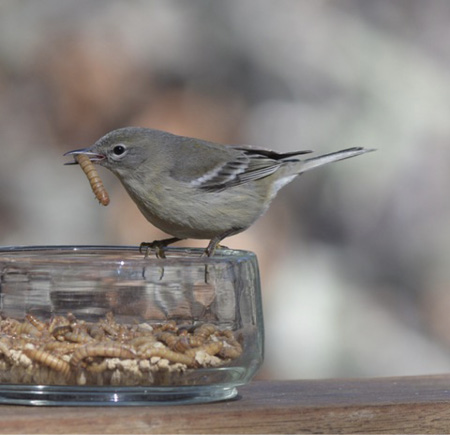Wayne R. Petersen

DAVID CLAPP
A species that eats mealworms! Though this clue may at first seem irrelevant, to backyard bird feeding devotees it may be just about all that is needed to identify this issue's mystery species. But before going down that road, let's concentrate on the bird itself.
Because this image is only viewable in black-and-white, readers are forced to use features other than color as identification clues. Characteristics to notice on the bird include a thin (but not tiny) bill, two prominent wing bars, two pale eye arcs around the eye, no obvious streaks on the back or the underparts, a diffuse pale patch on the side of the neck, and a relatively long tail. Using the shape of the bill and the overall conformation of the mystery species as clues, it bears the closest resemblance to a warbler of some sort.
Because the gizz (superficial overall impression) of the mystery bird is that of a warbler, careful examination and comparison of the bird's features is in order. The obvious wing bars and unstreaked underparts of the mystery warbler at once narrow the field to Blue-winged Warbler, Northern Parula, Bay-breasted Warbler, Chestnut-sided Warbler, and Pine Warbler. All other eastern warblers with prominent wing bars have at least some obvious streaking on their breast, sides, or flanks—a factor that eliminates the majority of otherwise potentially similar-looking species. Of the five listed species, Blue-winged can be eliminated by the absence of a distinct black eye line; Northern Parula by its tiny size, small bill, and short tail; Chestnut-sided by the absence of a complete white eye ring and a light gray face; Bay-breasted by streaks on its back, a relatively shorter tail, and bright green sides to the neck and buffy undertail coverts (neither, unfortunately, can be seen in the black-and-white photo).
With four of the warbler species above eliminated, only the Pine Warbler (Setophaga pinus) remains as a solid identification candidate. And as noted in the opening sentence, Pine Warblers love to eat mealworms during the winter when they occasionally visit backyard bird feeders in small numbers, especially near the coast and on Cape Cod and the Islands.
Pine Warblers are fairly common and widespread in Massachusetts wherever there are extensive pitch pine or white pine woodlands, especially from Plymouth southeastward to Cape Cod and the Islands. Residents arrive in late March and regularly remain until mid to late fall, with small numbers frequently remaining through the winter, where they often appear at feeders to feed on suet or mealworms.
David Clapp photographed this female Pine Warbler on February 8, 2020, at his Cape Cod feeder in Brewster, Massachusetts.
Wayne R. Petersen